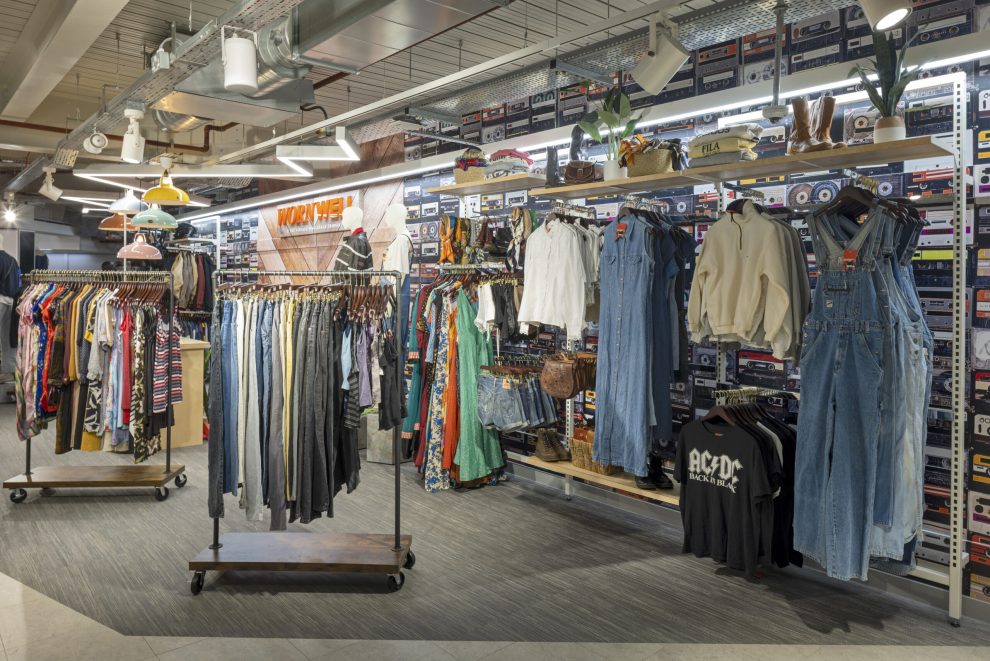The resale fashion market isn’t new. Initially customers knew them as charity or thrift shops, but in recent years interest in this sector has skyrocketed due to heightened concerns around the environment and the ethical impacts of fashion.
As inflation and rising energy costs all contribute to a cost of living crisis, particularly in the UK, shoppers are turning to cheaper, non-essential alternatives to brand new clothing, and even the cheaper fast fashion.
Market drivers
According to a report by GlobalData entitled ‘Global Apparel Resale Market & Forecasts to 2026’, the resale apparel market soared by 109.4% between 2016 and 2021.
The increased dominance of online resale platforms, like Depop and Vinted, has supported this growth, especially since the pandemic, when people were forced to shop online amid store closures or use platforms such as these to sell items they had cleared out of their wardrobes during lockdowns.
In October 2020, European second-hand fashion marketplace Vinted acquired what is claimed to be the largest second-hand fashion platform in the Netherlands, United Wardrobe. A year later the company raised EUR250m (US$301m) in Series F funding to accelerate its growth and invest in technology.
The company operates in over ten markets and claims to have become the largest online consumer to consumer (C2C) marketplace in second-hand fashion across Europe.
Driven by customer concerns over the lack of sustainability within the fashion industry and the need to offer more affordable alternatives, bigger brands are entering the resale market to stay competitive. In-house resale services instead of third-party platforms are particularly popular as brands can target their existing shopper base while also attracting new customers.
In February 2022 H&M launched a resale section on its Swedish website in partnership with recommerce platform, Sellpy. Its online offering of pre-loved items in its domestic market features second-hand garments from its own brands in addition to other third-party brands such as ASOS, NIKE, Zara and Abercrombie & Fitch.
H&M bought a majority stake in Sellpy in 2019 and earlier this year, it launched an app with the aim of making it easier for consumers to buy second-hand.
Others jumping on this trend include Primark, Levi Strauss, Lululemon and Hugo Boss who is set to launch a resale service called ‘Hugo Boss PreLoved,’ in France during the third quarter.
Targeted growth
The resale fashion market is expected to grow as shoppers continue to tighten their belts while seeking ways to save cash. In 2022 the market is expected to grow by a further 31%, and between 2023 and 2026 this is expected to increase by a further 52% thanks to the emergence of new players.
However, according to GlobalData’s report, growth is expected to begin to slow slightly as the market becomes more established in key markets.
Since 2016, Asia Pacific has experienced the largest growth within the global apparel resale market as the stigma towards resale has faded away. The region is also forecast to see the largest market growth in the forecast period (91.9% from 2022- 2026) thanks to its large population, growing economies, and a focus on luxury in core countries like China and Singapore.
The Americas has suffered the largest fall in share due to an established market in the US, and lower online penetration in Latin America restricting accessibility to digital resale platforms. Meanwhile, Europe’s share is expected to remain relatively constant out to 2026.
Other key forecasts include:
Eastern Europe will lead the growth in the resale market thanks to its growing economy and the high presence of online resale platforms like Vinted.
Asia Pacific will be the fastest growing region thanks to its large and growing population and penchant for luxury goods.
South America and MEA’s growth will remain hindered by low online penetration, meaning resale is focused on more traditional offline channels.
The Chinese resale market will grow rapidly thanks to a strong appetite for luxury fashion and unique styles.
Market inhibitors
While there is clearly a growing market for resale fashion, inflation, the emergence of new trends, and negative perceptions in some countries are expected to cause challenges.
In Europe and North America, inflation has become a huge stress for both consumers and retailers as discretionary income shrinks, and consequently spend on non-essential items such as clothing and footwear. Consumers could also contribute to excess supply in the market as they try selling clothes to make money.
It is worth noting that most resale platforms operate online only so the challenges of not being able to try on or touch products before buying remain. Consumers also have to consider the quality of the garments when purchasing second-hand and the subsequent rate of returns.
In some countries, such as Saudi Arabia and the UAE, there is still a stigma around purchasing secondhand fashion, but these views are slowly changing, especially among Millennials and Gen-Z, who are more concerned about ESG. It has become more important than ever for brands and retailers to work together to alter the negative perceptions around secondhand clothing and highlight the sustainable benefits of purchasing a pre-loved item.
Strategies for success
GlobalData’s report offers a number of strategies that brand and retailers can deploy if they want to remain successful in the global fashion resale market.
Increasing inclusivity – Offer a wider size range as most listings often lack inclusivity. This can include options such as petite, tall, plus size and leg length filters.
Promote sustainability – Resale platforms are ahead of traditional retailers in terms of sustainability due to the items’ circularity credentials, but resale platforms need to share this to attract shoppers.
Promote affordability – The low prices of products found on resale platforms is a unique selling point which players should tell consumers, especially as the cost of living crisis continues to bite.
Source: Just Style






















